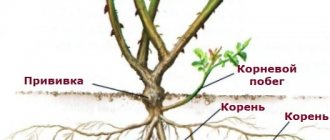- Simple and improved
Growing roses in most Russian regions is fraught with difficulties, primarily associated with insufficient winter hardiness of plants. To obtain bushes more adapted to local conditions, specialists from nurseries producing planting material and experienced rose growers use various methods of grafting roses onto rose hips. If you are ready for such experiments, then be patient - a successful result may not be obtained the first time and you will have to wait for several years.
Grafting technologies are also used in the formation of spectacular pink “trees” with a high trunk
We offer information about the most frost-resistant varieties of crops and brief descriptions of popular varieties in the article on our website.
Is it possible to graft a rose onto a rosehip?
To simplify growing roses, gardeners use the technology of budding a flower onto a rose hip bush - thus, the plant takes on a well-groomed and impressive appearance. According to both beginners and experts, this is not difficult to do. But it is worth considering some nuances:
- you need to have special tools with you, for example, a budding knife;
- it is necessary to create stable conditions for the plant with a certain temperature, humidity and lighting;
- the bush must be at least three years old and accustomed to weather conditions.
How to graft a rose onto a rosehip
To get started you will need the following tools:
- budding knife;
- pruner;
- garden scissors.
Choose your tools responsibly; they determine how well the grafting will be done.
Pay attention to their cleanliness. Step-by-step instructions for budding rose hips:
- Before starting the procedure, you need to prepare the bush. It is enough just to water it abundantly.
- On the day of grafting, cut the stalk with pruning shears. A cutting is a small part of an annual stem that has already acquired buds. You need to cut off the strongest part; 2-4 buds should remain on it. There should be nothing unnecessary on the young stem - thorns and leaves must be cut off. This is done with a budding knife.
- Prepare the plant you will be grafting onto. Clean the neck (the junction of the trunk and the root) from soil and dirt. This is where the vaccination will take place.
- Using the same knife, carefully cut off the bud from the cutting along with the bark and a small piece of the inside. The resulting segment should be approximately 3 cm long.
- Carefully remove the top thin layer of bark.
- Use a knife to make a deep cut in the neck, resembling the letter “T”, similar in size to the previously cut off kidney. Insert a piece of the cutting into the split.
- Securely secure the structure with strapping material, while the kidney should remain open. The result of the vaccination will depend on this.
- Cover the graft with damp soil. If the cuttings require storage, it would be correct to cover their sections with paraffin, then wrap them in plastic and send them to a cold place until the grafting is done.
Tools and strapping material
Grafting is an operation and its implementation requires not only the skillful hands of a gardener, but also high-quality gardening tools. To work with the material (scion, rootstock), you can use the following tools:
- grafting pruner;
- budding knife;
- gardening scissors.
The grafting pruner has replaceable knives and makes it easier to make cuts of the same size on scions and rootstocks. Well-made cuts guarantee a good result. Cut the cuttings with garden shears. Models made of high-strength steel, small in size, with rubberized handles are easy to use.
Purpose of the budding knife: to make even T-shaped cuts, cut off the shield. The blade has a special knuckle for separating the bark from the wood. The edge is sharpened on one side, the sharpening angle is sharp
The quality of the steel from which the blade is made and its thickness are important; it should not exceed 2 mm. To sharpen the blade, you need a coarse-grained stone and Goi paste for polishing
On a note. The result of grafting depends not only on the quality of the instruments, but also on its cleanliness.
You can make the strapping material yourself or purchase it at a specialized store. Usually they simply cut the tape to the required width from a suitable material:
- polyethylene film;
- medical oilcloth;
- electrical tape.
When budding, the width of the tape is 15 mm, the width of the strapping for fixing the cutting is 25 mm.
Choosing a vaccination site
For grafting, you can choose any rose or rose hip bush available on the site. As the practice of gardeners shows, grafting with eyes takes root better than with cuttings. The eye itself can be healed anywhere - both on the stem and directly to the root collar. But if the cleft grafting method is chosen, it is important that the rootstock and scion are of the same thickness, and the bush itself on which the grafting will be performed should be pruned low.
Did you know? Rose hips contain large amounts of vitamins C, P and K.
The place where the bush grows on which the grafting is performed does not play an important role in this matter.
The location should not be too shaded, but at the same time avoid direct sunlight. The main thing is healthy and fertile soil, which is regularly watered and fertilized. These are classic conditions needed by many plants, so providing them is not difficult.
Video: How to graft a rose onto a rosehip
When is the best time to vaccinate?
Experienced gardeners recommend doing this in late spring (April - May) or summer (July - August). Vaccination is carried out less often in the fall, since conditions are less favorable for development. Some people graft plants even in winter, in February, but this process is quite labor-intensive and requires at least minimal experience and a lot of patience. In winter, naturally, budding is done indoors, because at this time of year it is almost impossible to grow anything outside.
in spring
Spring is the recommended period for the procedure. You will expect good results with minimal time spent. In the spring, sap flow begins - nutritious juice is produced, saturating the plant. Thanks to this process, you will be able to get a rose bush much faster.
In summer
Time for active juice production and saturation of flowers. This will have a good effect on future roses - they will be healthier and stronger. But the summer period is inferior to the spring in that you have to wait longer. If quality is important, not beauty, then gardeners recommend carrying out the operation in the summer.
Did you know? Even if you cross two fragrant varieties of roses, you will get a flower with a barely noticeable or no scent.
in autumn
Budding is not carried out in the fall. The reason for this is that the weather is unsuitable for growing - temperature changes, heavy rains and cold winds do not contribute to the development of roses, and can even ruin everything.
What should the scion be like?
The key to successful vaccination is the correct choice of graft. To get a scion from the mother bush, you need to cut off the most mature branches. Next, their middle part is separated.
The scion should have smooth and shiny bark, as well as developed buds. Branches with such characteristics are grafted very easily.
Experienced gardeners, in order to increase the chances of better survival, advise using the budding method. This method will be discussed below. Its use guarantees 90–100% vaccination effectiveness. Here one bud is taken, and not a whole cutting.
Features of grafting rose hips onto rose hips
A different method is used to graft branches. The cutting and scion branch are cut obliquely at the same angle. Next, the cut cutting is tightly pressed at the cut site to the stem, where a part was also cut off earlier, and tightly wrapped with binding material. This method is ideal for grafting rose hips to rose hips. This method can be used to graft homemade roses and even flowers from a bouquet.
Preparation of the rootstock
Rosehip is a completely worthy rootstock for roses and often plays this role. It has a strong and well-developed root system, and also has good resistance to pests and diseases. A rose that is properly grafted onto a rose hip has sufficient winter hardiness.
As a rule, stockpiling is carried out in the autumn:
ideal for harvesting is a rosehip bush with powerful and long young shoots without branches growing from the base; Using a sharp pruner, you need to cut out all the shoots, and leave one, the most powerful one, to form a rose trunk; the side branches from the left shoot must be shortened to a length of 20 cm, after which the plant should be carefully dug up; Rose hips prepared in this way should be stored in a cool room until spring; in early spring, you should inspect the rootstock for the presence of dead or broken roots, carry out sanitary pruning and immerse them in a clay mash with the addition of a root formation stimulator
When planting a rootstock in a permanent place, you should be sure to deepen not only the root collar, but also the beginning of the stem part. Planting should be carried out in an area allocated for the flower garden.
You can grow rootstock material from rosehip seeds, but this method is more labor-intensive and time-consuming.
Further care of the plant
Grafting is a great stress for the plant, so it needs special conditions for further successful development. If you do not follow these steps, the entire budding may lose its meaning because it will not give the expected results.
- The bush must be watered abundantly so that after damage by a knife it can recover faster.
- It is necessary to carefully monitor the soil. It is necessary to clear the land of weeds and prevent pests. Pay attention to fertilizer.
- With the onset of autumn, the first shoots must be cut off and covered generously with soil, and in winter covered with snow.
- In the spring, dig up the ground and cut the rootstock, retreating half a centimeter, and treat the cut with garden varnish. A few weeks later the roses will begin to grow a little.
We suggest that you familiarize yourself in more detail with information on how to graft a rose onto a rosehip.
Optimal watering
Although rosehip is a plant that survives in fairly dry conditions and does not like high humidity, it needs to be watered with plenty of water after the pink flowers appear on it. It is better to do this early in the morning or in the evening. Watering should be regular and with approximately the same amount of water. Make sure that the drops do not remain on the leaves, otherwise there is a risk of sunburn on them. Water carefully, and if drops appear, wipe with a dry cloth.
How and with what to fertilize
There are several types of fertilizers:
- dry, in the form of powders;
- pills;
- liquid fertilizer.
Important! When using a liquid mixture, feed it only if the soil has been previously moistened. Direct contact with the chemical may cause burns that will ruin the root.
The plant needs to be fed in spring and summer, when changes occur in its development. Consider its needs and select fertilizers depending on the needs. Pay attention to the composition. The fertilizer should contain various elements that have a positive effect on development and growth. The plant needs phosphorus, potassium, magnesium, nitrogen.
In any business, the main thing is the experience gained and study. With every mistake a person learns and learns something new. It won't always work out right the first time, and this doesn't just apply to gardening. However, if you are careful, strictly follow the instructions and listen to advice, you can achieve excellent results and enjoy the beautiful view from the window.











